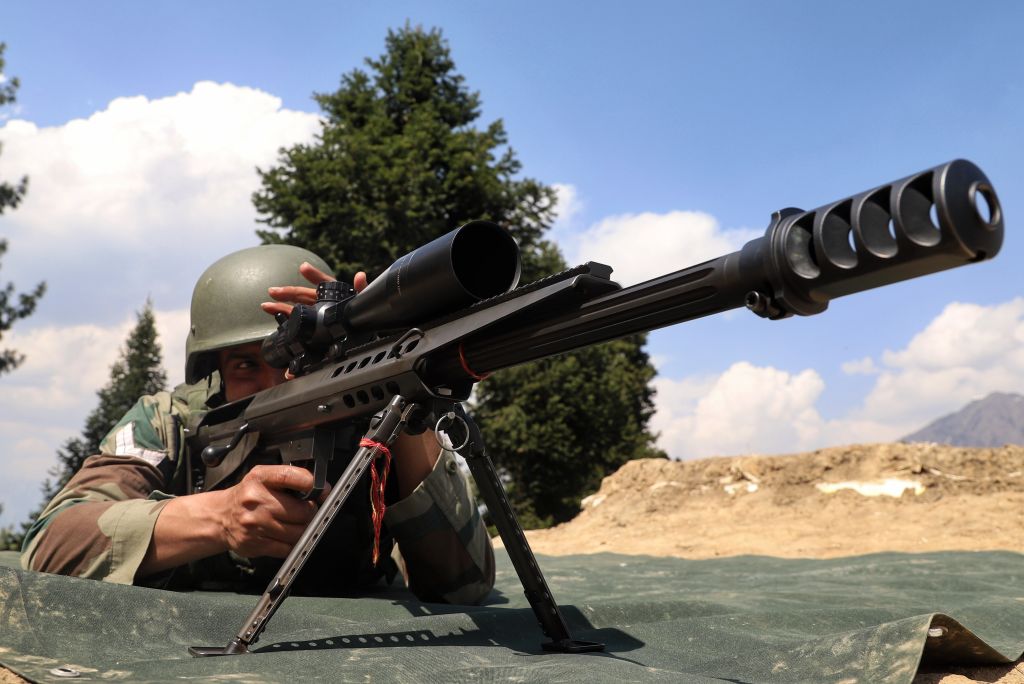synopsis
The Indian Army is modernising its sniper units with advanced rifles, optics, AI-driven targeting, and UAV integration to enhance precision, reconnaissance, and strategic deterrence in diverse combat scenarios.
From the trenches of World War I to the dense urban battlegrounds of contemporary conflicts, snipers have played a decisive role in shaping military engagements. These elite marksmen, once viewed as solitary specialists, have evolved into indispensable assets in modern warfare. As military strategies shift toward asymmetric and hybrid conflicts, the role of snipers has expanded beyond precision shooting to intelligence gathering, reconnaissance, and psychological warfare.
The Indian Army, long recognising these evolving dynamics, has significantly invested in modernising its sniper units for high-altitude combat, jungle warfare, counterinsurgency, and operations along the volatile Line of Control (LoC). Reports indicate that these developments are part of broader modernisation efforts within India's infantry and combat strategies.
Technology at the Crosshairs: Optics, Rifles, and Gear
Recent technological advancements have revolutionised sniping, turning the complex specialisation into an even more high-tech battlefield discipline. The days of relying solely on manual calculations and intuition are over. The Indian Army has been actively acquiring modern sniper rifles, sophisticated ballistic software, and advanced optical systems that increase accuracy and lethality. Among the sniper rifles in service with the Indian Army are the Sako TRG-42 and 7.62mm Dragunov, both revered for their adaptability to different combat environments.
The Sako TRG-42, designed for long-range engagements, can accurately hit targets at over 1,500 meters, while the Dragunov, though older, remains in use for specific tactical roles. Reports suggest that the Indian armed forces are actively replacing the Dragunov with the Sako TRG-42, chambered in .338 Lapua Magnum, underscoring the military's commitment to sniper modernisation as part of broader defence reforms.
Optics have also undergone dramatic improvements. The integration of thermal imaging scopes, night vision devices, and laser rangefinders allows Indian Army snipers to operate effectively in extreme conditions. Ballistic calculators built into modern scopes can compensate for variables such as wind speed, altitude, and temperature, improving accuracy by up to 30%. Reports going back a few years highlighted the Indian Army's plan to procure 4,800 new sniper rifles and 7.8 million rounds of ammunition, a clear indication of the growing importance of precision marksmanship in India's evolving military strategy.

Training the Perfect Marksman: Precision, Patience, and Tactics
A sniper's prowess is not merely a function of superior weaponry; rigorous training and tactical discipline are equally crucial. The Indian Army has overhauled its sniper training programs to enhance precision, adaptability, and endurance in combat environments. This shift is being done both institutionally and even at the individual corps level.
For instance, it was reported that specialised high-altitude sniper training was being conducted by the Brahmastra Corps of the Indian Army's Eastern Command, focusing on camouflage, survival, surveillance, and precision shooting in challenging terrains.
Additionally, India's participation in joint military exercises, such as Yudh Abhyas with the United States, has continually exposed Indian snipers to cutting-edge techniques in urban warfare and counterinsurgency. These exchanges have been particularly beneficial in refining tactics applicable to operations in Kashmir and other high-risk zones.
Snipers as a Strategic Deterrent: The Indian Context
Snipers are not just battlefield assets; they serve as a force multiplier and an asymmetric deterrent. Along the LoC, reports suggest that Indian Army snipers play a pivotal role in monitoring infiltration routes and neutralising threats before they materialise. The integration of unmanned aerial vehicles (UAVs) with sniper operations has further augmented their effectiveness, allowing for real-time reconnaissance and target acquisition.
The Indian Army is seen as actively increasing its sniper deployment, with each infantry battalion reportedly authorised to maintain 10 sniper rifles. Given that the Army comprises 360 Infantry Battalions, 46 Assam Rifles Battalions, and 65 Rashtriya Rifles Battalions, this translates to approximately 4,720 sniper rifles in service. This structured deployment ensures that snipers remain a crucial element of India's tactical and strategic military posture.

Next-Generation Sniping: The Future of Precision Warfare in India
The future of Indian Army sniping is poised for even greater transformation, driven by advances in artificial intelligence, drone technology, and smart ammunition. AI-powered targeting systems can now compute ballistic trajectories in real time, drastically reducing the sniper's cognitive workload while enhancing shot accuracy.
Drones are expected to reshape sniper operations further. Future UAVs with high-resolution cameras, infrared sensors, and live battlefield feeds will provide unparalleled situational awareness, allowing Indian snipers to confidently make split-second decisions.
Another revolutionary development is smart ammunition, which includes guided bullets capable of adjusting trajectory mid-flight. Such technology, once the domain of science fiction, is now approaching battlefield deployment, promising to extend effective engagement ranges and redefine sniper warfare.
Also read: Indian Army's next leap: From advanced bulletproof jackets to exoskeleton technology
The Unseen Game-Changers of the Indian Army
The transformation of snipers from lone gunmen to technologically sophisticated operators highlights their growing significance in the Indian Army's military doctrine. Whether operating in the mountainous borders along the LoC, counterinsurgency operations in dense forests, or urban warfare scenarios, snipers continue to exert a profound influence on modern battlefields. Their ability to deliver precision firepower, gather critical intelligence, and shape enemy behaviour makes them a formidable force in contemporary warfare.
Reports suggest that India's renewed focus on enhancing sniper capabilities is not an isolated trend but part of a long-term strategy to bolster its combat effectiveness. As warfare evolves, so too will snipers, adapting to emerging threats, integrating with new technologies, and remaining the silent, unseen spectres who dictate the tempo of battle.
In an era where information dominance, adaptability, and surgical precision define military success, snipers will continue to be at the forefront of India's combat modernisation efforts, one calculated shot at a time.
(Ashu Mann is an Associate Fellow at the Centre for Land Warfare Studies and is pursuing a PhD in Defence and Strategic Studies at Amity University, Noida.)
)
 subscribe to Asianet News Whatsapp channel by clicking here.
subscribe to Asianet News Whatsapp channel by clicking here.